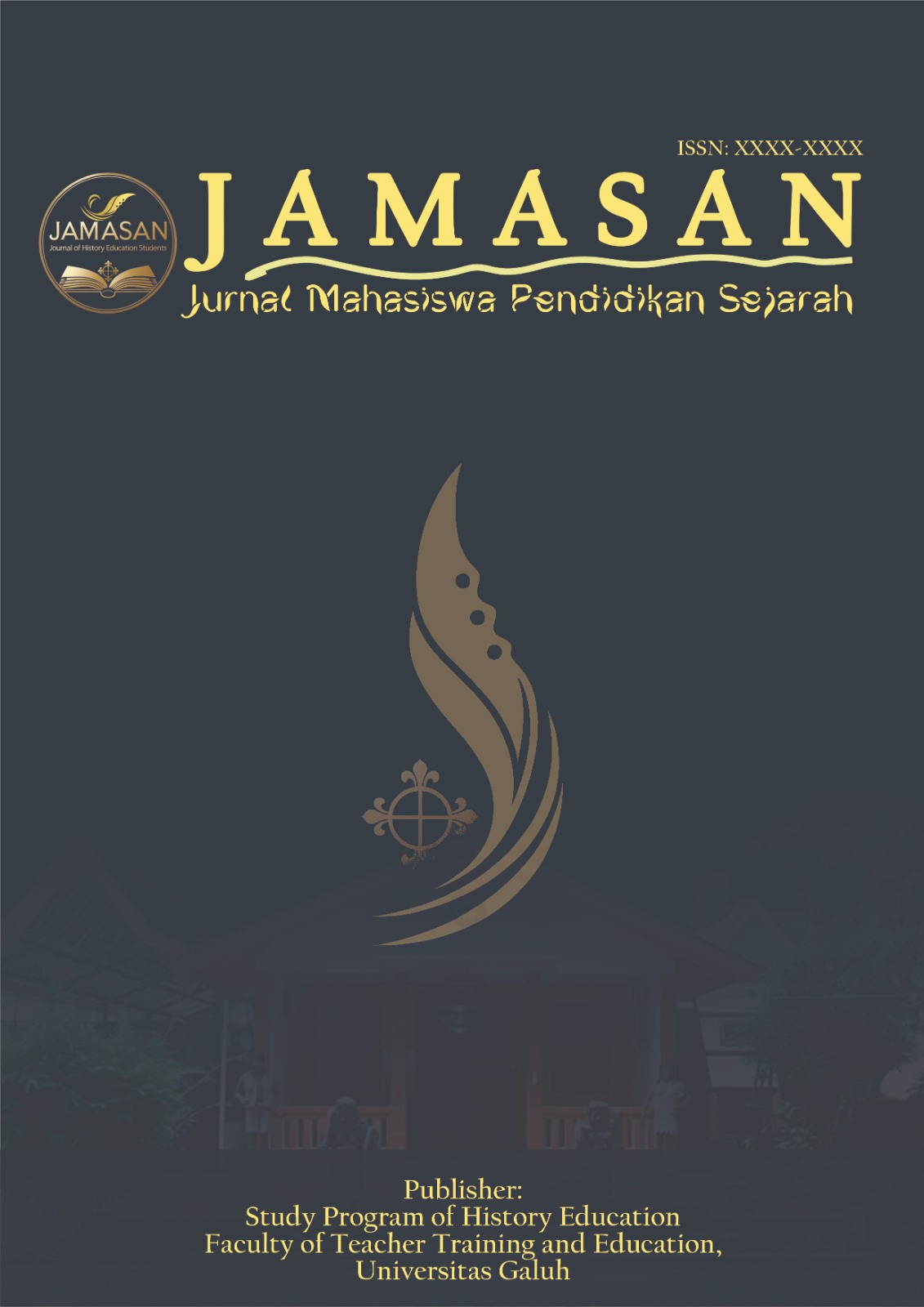Ethnocultural Linguistic Study of the Concept of Nationality in the Sunda Wiwitan Community of Kampung Pasir Garut
DOI:
https://doi.org/10.25157/jamasan.v1i1.5368Keywords:
Local religion, Sunda Wiwitan, Ethnolinguistics, Nationality, Community of PasirAbstract
Local religion is one form of pluralism of beliefs in Indonesia. This is because of the long history of the formation of the Indonesian nation. Local religions are spread throughout Indonesia from Sabang to Merauke. One of the local religions in Indonesia is located in West Java Province, precisely in the Sundanese tribe, which is called the Sunda Wiwitan belief. Sunda Wiwitan is a religious belief that has existed since the ancient kingdom era. This belief upholds the values of Sundanese customs and Sundanese culture. In one of its teachings, it is known as the terms kondisi cara ciri manusa kabangsaan and kondisi cara ciri bangsa kabangsaan. This concept describes the way the Sunda Wiwitan people live as fellow human beings and as part of a nation. This concept is adopted by the Sunda Wiwitan belief in the Kampung Pasir area in Samarang District, Garut Regency
References
Aditya et al., 2024. "Unsur Kebahasaan yang ada di Kepercayaan Sunda Wiwitan Kampung Pasir". Hasil Wawancara Pribadi : 22 Desember 2024, Kampung Pasir, Samarang, Garut.
Amri, Harianto et al. (2019). "Bambu sebagai Material Bangunan Berkelanjutan di Indonesia". Jurnal Arsitektur Tropis Vol. 7, No.1.
Anderson, B. (1983). Imagined Communities: Reflections on the Origin and Spread of Nationalism. Verso.
Andini, S., Sudarto, S., Ayatullah, A., & Farhan, H. M. (2025). Language Politeness in Javanese and Sundanese Border Cultural Landscapes in Elementary School Student Learning. Journal of Innovation in Educational and Cultural Research, 6(4), 681-691. https://doi.org/10.46843/jiecr.v6i4.2354
Bascom, William. 1965. African Dilemma Tales: An Introduction to Yoruba Literature. Northwestern University Press.
Durkheim, E. (1984). The Division of Labor in Society. Free Press.
Fishman, J. A. (1991). Reversing Language Shift: Theoretical and Empirical Foundations of Assistance to Threatened Languages. Multilingual Matters.
Fishman, J. A. (2001). Can Threatened Languages Be Saved? Reversing Language Shift, Revisited: A 21st Century Perspective. Multilingual Matters.
Geertz, Clifford. (1976). The Interpretation of Cultures. Basic Books.
Grenoble, L. A., & Whaley, L. J. (2006). Saving Languages: An Introduction to Language Revitalization. Cambridge University Press.
Hefner, Robert W. 1985. Hindu Javanese: Tengger Tradition and Islam. Princeton University Press.
Heryanto, Ariel. (2017). Identity and Pleasure: The Politics of Indonesian Screen Culture. NUS Press.
Hymes, D. (1974). Foundations in Sociolinguistics: An Ethnographic Approach. University of Pennsylvania Press.
Kartakusuma, R. (2006). Rasionalisasi Ideologi Sunda Wiwitan (Kabuyutan): Penyatuan Diri Urang Sunda Kepada Gunung Sebagai Lambang Semesta (Kosmis). Berkala Arkeologi, 26(1), 86–94. https://doi.org/10.30883/jba.v26i1.927
Kırbıyık, S. (2004). No 主観的健康感を中心とした在宅高齢者における 健康関連指標に関する共分散構造分析 Title. Metallurgical and Materials Transactions A, 30(8), 2221.
Koster, Ferry. 2006. "Sunda Wiwitan as an Indigenous Religion". In: Journal of Indonesian Social Sciences and Humanities, Vol. 1, pp. 23-38.
Kurin, R. (2004). Safeguarding Intangible Cultural Heritage in the 2003 UNESCO Convention: A Critical Appraisal. Museum International, 56(1-2), 66-77.
Kvale, S. (1996). InterViews: An Introduction to Qualitative Research Interviewing. Sage Publications.
Littlejohn, S. W., & Foss, K. A. (2008). Theories of Human Communication. Waveland Press.
Melina, M., & Azeharie, S. S. (2020). Ritual Sajen pada Penganut Sunda Wiwitan (Studi Komunikasi Budaya pada Penganut Sunda Wiwitan). Koneksi, 3(2), 427. https://doi.org/10.24912/kn.v3i2.6431
Muttaqien, A. (2013). Spiritualitas Agama Lokal. Al-Adyan, 8(1), 89–102. http://103.88.229.8/index.php/alAdyan/article/view/528/353
Nas, Peter J. M. (2000). Urban Symbolism. Brill Academic Publishers.
Rasyid, S. (2016). Klasifikasi Kosakata Permainan Rakyat Melayu Sambas: Pendekatan Etnolinguistik. Bahastra, 35(2), 75–101. https://doi.org/10.26555/bahastra.v35i2.4863
Risdayah, E. (2019). Tasawuf Nusantara; Tentang Nilai-nilai Mistis dalam Agama Sunda Wiwitan di Kampung. Dsyifa Al-Qulub., 1(Juli), 59–67. https://doi.org/10.15575/saq.v
Spradley, J. P. (1980). Participant Observation. Holt, Rinehart and Winston.
Sudarto, S., Wijayanti, Y., Pramesti, C. S., & Agustina, D. D. (2024). Pengelolaan Pertanian Berkelanjutan Berbasis Eco-spirituality dalam Tradisi Komunitas Adat Dan Implikasinya Terhadap Ketahanan Cultural Socio-Ecological System (Studi Pada Tradisi Komunitas Adat Di Tajakembang–Cilacap). Jurnal Ketahanan Nasional, 30(3), 367-390. https://doi.org/10.22146/jkn.100561
Sudarto, S., Warto, W., Sariyatun, S., & Musadad, A. A. (2024). Cultural-Religious Ecology Masyarakat Pesisir Cilacap. Danadyaksa Historica, 4(2), 9-21. https://doi.org/10.32502/jdh.v4i2.8993
Suryana, A., Ratih, D., Sudarto, S., Sondarika, W., Wijayanti, Y., Kusmayadi, Y., ... & Wahyunita, R. (2024). Peranan Budaya Kampung Adat Kuta Di Era Globalisasi. http://repository.unigal.ac.id:8080/handle/123456789/6128
Tajfel, H., & Turner, J. C. (1979). An integrative theory of intergroup conflict. In W. G. Austin & S. Worchel (Eds.), The social psychology of intergroup relations (pp. 33–47). Monterey, CA: Brooks/Cole.
Tyler, T. R. (1990). Why People Obey the Law. Yale University Press.
UNESCO. (2003). Convention for the Safeguarding of the Intangible Cultural Heritage. Paris: UNESCO.
Yao, X. (2000). An Introduction to Confucianism. Cambridge University Press.
Downloads
Published
How to Cite
Issue
Section
License
Copyright (c) 2025 JAMASAN: Jurnal Mahasiswa Pendidikan Sejarah

This work is licensed under a Creative Commons Attribution 4.0 International License.
Articles published in JAMASAN: Journal of History Education Students are licensed under:
Creative Commons Attribution 4.0 International (CC BY 4.0)
This license allows readers and users to:
-
Copy, distribute, display, and adapt the work.
-
Use the work for any purpose, including commercial use.
Under the following conditions:
-
Attribution – Users must give appropriate credit to the original author(s) and the journal, provide a link to the license, and indicate if changes were made.
-
No additional restrictions – Users may not apply legal terms or technological measures that legally restrict others from doing anything the license permits.
Copyright remains with the author(s), while the journal retains the right of first publication.


